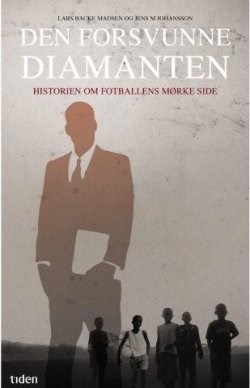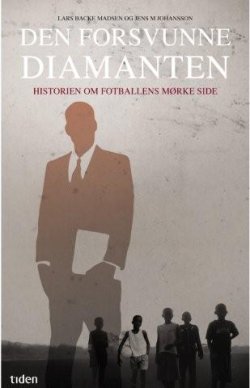Review of Den Forsvunne Diamanten (The Lost Diamond)

01.12.2008
By Maria Suurballe |
| Den Forsvunne Diamanten by Lars Backe Madsen and Jens M. Johansso |
“You are in Africa hunting for the fabled diamond ‘The African Star’ which you will have to bring to Cairo or Tangier. On the way you might find other precious diamonds which you can take up for money for your trip through Africa. The more money you obtain the easier will it be for you to move and find short cuts with flights or boats. At any time thieves, Bedouins and pirates can attack, and should one of the other players find the ‘African Star’ before you, you will have to search for a visa and reach Cairo or Tangier before him in order to win the game.”
With these words the book completes its travel through the dark sides of the trafficking with young football players. The quotation stems from the board game “The African Star” and in many ways it describes very precisely the existence of European agents and scouts hunting for young and talented African football players. They are hunting all over the Continent although the hunt is concentrated around the “Slave Coast” in Western Africa wherefrom young boys are shipped to the North Coast of Africa and on to Europe, legally or illegally.
African players are highly valued in international football where the competition is increasingly about ‘cool cash’. But there is a technical problem for European clubs that wants to secure one of the “African diamonds”. In order to prevent trafficking in minors, the International Football Association, FIFA, has by the article 19 - protection of minors - made it illegal to buy and transfer players under 18 years of age from outside the EU.
In the case of Mikel, Chelsea, Manchester United and the Norwegian Club Lyn are some of the European Football Clubs that have proved ready to break the law. John Obi Mikel was too much of a precious diamond to lose.
In Den Forsvunne Diamanten the two Norwegian Journalists reveals how the famous English football club Chelsea in an illegal way secured the rights to John Obi Mikel when the Nigerian was just 16-years-old. Completely against the FIFA article 19.
Lars Backe Madsen and Jens M. Johansson present the Mikel case – and similar cases - in a very clear and objective manner. Documents crucial to the Mikel case are revealed in the book which is certainly worth reading for anyone with interest in International Football.
According to documents it was Mikel’s father, Michael Obi, who on 15 December 2003, through the agency SEM (Sports Entertainment and Media Group Limited), signed a deal on behalf of his son, thereby linking John Obi to Chelsea. In order to “keep Mikel warm” until he turned 18 and could legally be sold to Chelsea, John Obi Mikel was placed in the Oslo based Club Lyn. Apparently Chelsea should have paid around 2 million Norwegian Kroner for Mikel and another three minor Nigerian football talents.
Norway has become a popular stepping stone for young players from Africa who see it as an opportunity to work in a country that has relatively lenient immigration laws. However, under Norwegian law all minors must receive an 'education' to qualify for a visa. It's also an opportunity for clubs from the major European leagues to park players from Africa while they qualify for work permits.
Everything was apparently under control in the Norwegian Clun Lyn until the Director, Morgan Andersen, became greedy when he realised how talented and much sought after the young football player John Obi Mikel was. He saw a good deal by selling the Nigerian to Manchester United. The club had for years chased the young football prodigy.
But Morgan Andersen just forgot about his deal with Chelsea. On Mikel’s 18th birthday in April 2005 he simply changed the front page of the contract with Mikel and thereby presented a new legal contract, without a new signature from Mikel himself. A few days later the world could see John Obi Mikel pose in Manchester United’s red jerseys – he was going to play for the famous English club. Later it was revealed that this transfer was against Mikel’s own will. He wanted to play for Chelsea and in May 2005 he signed a contract with the club.
A 12 pages long secret “deed of settlement” between Chelsea FC, Manchester United, FC Lyn Oslo and John Obi Mikel was signed on 2 June 2006. The deal requires Chelsea to pay Manchester United GBP 12 million and Lyn GBP 4 million and to “forget” the case and keep quiet about what has been going on. But Manchester United had in fact already reported Chelsea to the police, to the Football Association (FA), UEFA, FIFA and the Norwegian Football Association (NFF).
All allegations and claims on behalf of Lyn and Manchester United were to be withdrawn after signing the document and thereby preventing further investigation from FIFA and the Police. In the deed’s article 11.2 the parties signed and promised that “Each of the Parties undertakes and warrants to the others that they shall not take any step to encourage any Football Authority or other statutory or judicial authority to investigate Mikel or his playing registration”. Case closed! Until two Norwegian Journalist’s opened it again!
The story raises many questions, one of these why FIFA, the same body that rules and imposes laws over the transfer system in international football, has apparently turned a blind eye to some of this decade’s most dark and intricate transfers.
By the way …
Mikel is still playing for Chelsea with three years left on his current deal. A new arrangement worth GBP 60,000-a-week is apparently to be signed within a shot time limit in order to keep the popular midfielder in the club.
”Den Forsvunne Diamanten” by Lars Backe Madsen and Jens M. Johansson, Tiden Norsk Forlag, Norway, October 2008. ISBN: 9788210050442






Do you know, when the book turn up in German?
Janine